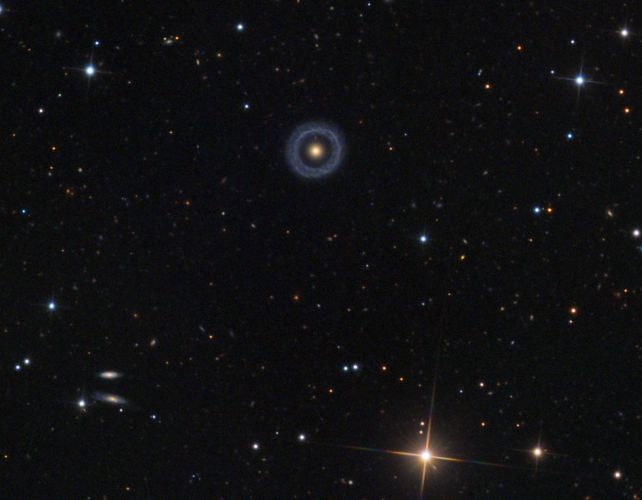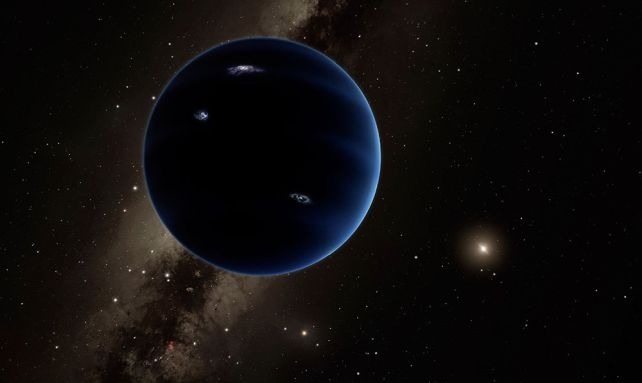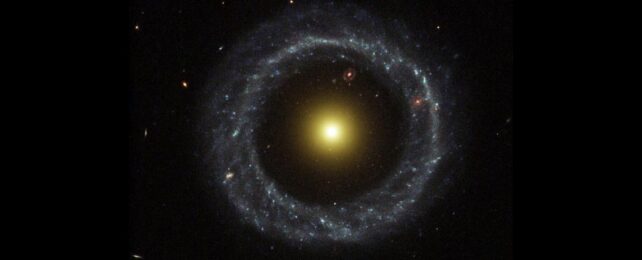Our cosmos seems, at times, like one impossibly vast factory, just pumping out mysteries.
The deeper we peer, the more we learn – but each new discovery stirs up a plethora of new puzzles to solve, like a swarm of fascinating science bees. Meanwhile, some burning questions have persisted across decades, resisting our best attempts to solve them.
Here's a selection of some of our favorite mysteries the Universe has to offer.
The Hubble Tension
We know, from several separate lines of evidence, that the Universe is expanding. What measurements can't agree on is the speed at which it is doing so.
Related: A Physicist Explains How to Imagine The Universe's Mind-Bending Expansion
There are two main ways to measure the speed of the Universe's expansion, known as the Hubble constant.
The standard ruler approach uses relics of the early Universe. These are things like the cosmic microwave background, or fossilized densities in the distribution of galaxies called baryon acoustic oscillations.

The standard candle approach relies on objects of known intrinsic brightness, such as Cepheid variable stars and Type Ia supernovae. Since these objects are presumed to emit a relatively consistent amount of light, we can work out how far away they are by measuring their apparent brightness.
Standard rulers consistently give a Hubble constant of around 67 kilometers per second per megaparsec. Standard candles, however, give a measurement of around 73 kilometers per second per megaparsec.
This unresolved discrepancy is known as the Hubble tension. It's been measured time and again, in many different ways; the likelihood that this is human error is very slim.
The good news is that scientists are a lot closer to solving this problem than they used to be, but the solution still remains tantalizingly elusive. The good news is that whoever does solve it will probably have a Nobel in the bag.
You can read more about the Hubble tension here.
Fast radio bursts

The first fast radio burst, or FRB, was discovered in 2007 in archival data collected back in 2001, and scientists were pretty boggled. Lasting just milliseconds, the incredibly powerful spike of radio light still discharged as much energy as 500 million Suns.
Since then, astronomers have detected thousands of these strange events, and they're still pretty odd. Most only flash once and then subside; a rare few repeat, sometimes with a predictable pattern of timing. Most of them come from galaxies outside the Milky Way, from a variety of environments.
One FRB was notably detected from within the Milky Way: the eruption of a magnetar as the outward pull of its powerful magnetic field warred against the inward pull of its powerful gravitational field.
Magnetars are likely the mechanism behind a great number of FRBs, astronomers believe, but questions remain. Are magnetars the only objects that can produce these bursts? Why do some of them seem to come from environments not expected to host magnetars? Why do some of them repeat? And what's behind the timing pattern of that rare handful?
The investigation continues…
Dark matter

As humanity turned its gaze to the depths of space last century, something strange began to emerge. The amount of normal, detectable matter in the Universe could not account for the gravity needed to make the Universe look and behave as it did.
If only visible matter existed, galaxies would rotate more slowly, and galaxy clusters would fly apart. In addition, the way space-time bends around massive objects is far too pronounced to be just the effect of gravity from normal matter.
Something out there is making excess gravity, and not just a little bit: whatever it is, it makes around five times more gravity than normal matter.
Normal matter is everything that can be catalogued. It's stars, and planets, and dust, and galaxies, and black holes. Whatever makes this extra gravity is not something we can directly detect. The only way it interacts with normal matter is gravitationally.
This stuff is known as dark matter, and although many attempts have been made to isolate what it actually is since astronomer Fritz Zwicky first theorized it in 1933, we still aren't a great deal closer.
There are a few theoretical candidates, but it might take a breakthrough in observing technology before physicists are able to narrow it down.
GRB 250702B

This is a new one, and what an absolute corker it is.
GRB 250702B was a gamma-ray burst detected in July 2025. Gamma-ray bursts are the most violent and powerful explosions that we've seen in the Universe, blazing with the most energetic form of light, gamma radiation. They're typically produced either by massive stellar cores collapsing into black holes or by neutron stars colliding and merging.
Prior to the detection of GRB 250702B, only a handful of gamma-ray bursts had ever been seen that lasted more than a few minutes. One exceptional burst seen in 2011 lasted for several hours.
GRB 250702B seems to have lasted an entire day, with repeated eruptions of gamma-ray activity.
Scientists are currently learning more about the galaxy from which the outburst originated to better understand how the event occurred, so we might be lucky enough to have some answers fairly soon.
Hoag's Object

With an uncountable number of galaxies absolutely teeming in the vastness of space, there are going to be a few oddballs… but they don't get much odder than Hoag's Object.
This strange galaxy, located around 600 million light-years away, has an utterly bizarre structure. It consists of a perfectly symmetrical ring of young, blue stars, and star formation regions about 120,000 light-years in diameter, neatly circling a yellow sphere of older stars about 17,000 light-years across, with a large, 58,000 light-year gap of apparently nothing in between. It's like a bullseye target in space.
Astronomers just don't know how it got this way. One theory is that something large punched through, leaving a big hole behind, but such an interaction would be extremely unlikely to leave behind such a tidily symmetrical galaxy. Another option is some sort of instability that effectively erased the middle section, but that doesn't quite work either.
It's possible that we'll simply never know.
Planet Nine

Some astronomers think a hidden planet may lurk far out beyond the orbit of Pluto, somewhere within the Solar System's vast frontier.
In this region of our planetary system, many small, icy objects swarm in a vast cloud. They're hard to detect, but astronomers are getting better at finding them – and the orbits of the ones discovered to date are clustered in a way that could mean they've been pushed around by the gravitational influence of a planet.
Such a planet would be around 5 times Earth's mass, calculations suggest, with an orbital period of around 5,000 years. However, surveys to find this hypothetical Planet Nine have so far turned up empty-handed, unless you count a bunch of moons around Saturn and Jupiter.
On the one hand, this is not super surprising: at an orbital distance several hundred times that of Earth's distance from the Sun, it's quite a long way away. An object the predicted size of Planet Nine would be a mere dark pinprick in the sky… and there's a lot of sky in which to look.
On the other hand, some scientists believe that the reason we haven't found it is because it doesn't exist, and the clustering of the icy objects is just an observation bias – that we perceive a pattern that isn't there because we're not looking at the whole picture.
The only way we're going to get to the bottom of this debate is if either Planet Nine turns up or astronomers find and characterize enough icy objects to unmask an observation bias.
Chop chop, scientists. Enquiring minds want to know.
What we don't know
If there's one thing that we are just completely in the dark about when it comes to space, it's the sheer breadth of all the things we are yet to discover. As bigger and more powerful instruments emerge, as our technology improves, so too will our ability to see details we don't even know exist.
We're in the best time yet for understanding the Universe, and it's only going to continue to get better from here.
